Themed collection Editors' collection: Supramolecular Polymers

Preparation and applications of peptide-based injectable hydrogels
The recent progress of peptide-based injectable hydrogels for biomedical applications is extensively summarized.

RSC Adv., 2019,9, 28299-28311
https://doi.org/10.1039/C9RA05934B
Molecular modelling of supramolecular one dimensional polymers
Hierarchical computational modelling approaches for the study of supramolecular polymers is reviewed.

RSC Adv., 2018,8, 22659-22669
https://doi.org/10.1039/C8RA03402H
Bioinspired temporal supramolecular polymerization
Nature's fuel-driven approach as a generic concept for structural and temporal regulation over biomimetic synthetic supramolecular polymerization.

RSC Adv., 2018,8, 18913-18925
https://doi.org/10.1039/C8RA03225D
Tuning the affinity of amphiphilic guest molecules in a supramolecular polymer transient network
Dynamicity plays a central role in biological systems, which can be mimicked by tuning dynamicity in hydrogel networks.
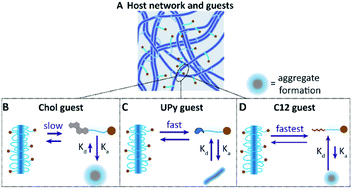
RSC Adv., 2022,12, 14052-14060
https://doi.org/10.1039/D2RA00346E
Fluorene benzothiadiazole co-oligomer based aqueous self-assembled nanoparticles
Self-assembled π-conjugated nanoparticles with tunable optical characteristics are appealing for sensing and imaging applications due to their intrinsic fluorescence, supramolecular organization and dynamics.

RSC Adv., 2020,10, 444-450
https://doi.org/10.1039/C9RA09015K
Mechanical and self-recovery properties of supramolecular ionic liquid elastomers based on host–guest interactions and correlation with ionic liquid content
Supramolecular ionic liquid elastomers showed higher fracture energy than chemically cross-linked ionic liquid elastomers and also self-recovery ability.

RSC Adv., 2019,9, 22295-22301
https://doi.org/10.1039/C9RA04623B
Design and synthesis of supramolecular functional monomers bearing urea and norbornene motifs
Design and synthesis of supramolecular functional monomers bearing urea and norbornene.

RSC Adv., 2019,9, 20058-20064
https://doi.org/10.1039/C9RA01852B
Nucleoside-lipid-based nanocarriers for methylene blue delivery: potential application as anti-malarial drug
Nucleolipids protects methylene blue against reduction (induced by light and chemical reductants) and do not impair antimalarial activity.

RSC Adv., 2019,9, 18844-18852
https://doi.org/10.1039/C9RA02576F
Self-assembly of supra-amphiphiles building block fabricated by β-cyclodextrin and adamantane-based ionic liquid
The self-assembly of supra-amphiphiles building block fabricated by β-CD and AD-C11im at diverse molar ratios was studied. The micelles of AD-C11im turned into monolayer vesicles, net-like nanofibers and hydrogel at different β-CD/AD-C11im system.
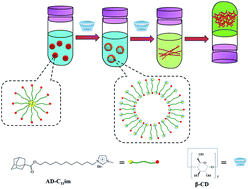
RSC Adv., 2019,9, 17281-17290
https://doi.org/10.1039/C9RA02738F
Spontaneous formation and reversible transformation between achiral J- and chiral H-aggregates of cyanine dye MTC
Spontaneous transformation from achiral J-aggregates to chiral H-aggregates of cyanine dye MTC was investigated.
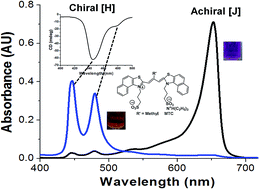
RSC Adv., 2019,9, 11365-11368
https://doi.org/10.1039/C9RA00063A
Circularly polarized light modulated supramolecular self-assembly for an azobenzene-based chiral gel
An unconventional supramolecular self-assembly triggered by left-handed circularly polarized light breaks the traditional knowledge of azobenzene photoisomerization.

RSC Adv., 2019,9, 10360-10363
https://doi.org/10.1039/C9RA01974J
Conformational transition of a non-associative fluorinated amphiphile in aqueous solution. II. Conformational transition vs. supramolecular assembly
Conformational transition in non-associative fluorinated dendrimer—a way to novel unconventional amphiphiles.
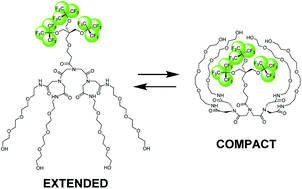
RSC Adv., 2019,9, 1956-1966
https://doi.org/10.1039/C8RA08795D
Metallo-supramolecular polymers derived from benzothiadiazole-based platinum acetylide complexes for fluorescent security application
Metallo-supramolecular polymers with the incorporation of benzothiadiazole-substituted organoplatinum moiety have been successfully constructed.

RSC Adv., 2018,8, 40794-40797
https://doi.org/10.1039/C8RA08615J
Fluorescent supramolecular hydrogels self-assembled from tetraphenylethene (TPE)/single amino acid conjugates
TPE-Ser molecules exhibit non-covalent interactions necessary for hydrogelation under physiological pH conditions.

RSC Adv., 2018,8, 20922-20927
https://doi.org/10.1039/C8RA02296H
Diasteroselective multi-component assemblies from dynamic covalent imine condensation and metal-coordination chemistry: mechanism and narcissistic stereochemistry self-sorting
Enantio narcissistic self-assembly is observed in a multi-metallic structure used as stereodynamic probe for CD measurements.
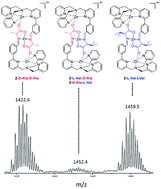
RSC Adv., 2018,8, 19494-19498
https://doi.org/10.1039/C8RA03989E
Supramolecular hydrogels encapsulating bioengineered mesenchymal stem cells for ischemic therapy
We developed supramolecular hydrogels encapsulating bioengineered mesenchymal stem cells for ischemia therapy.

RSC Adv., 2018,8, 18771-18775
https://doi.org/10.1039/C8RA00464A
The role of amino acids on supramolecular co-assembly of naphthalenediimide–pyrene based hydrogelators
The importance of side chains of amino acids for NDI–Py co-assembled hydrogelation is described.
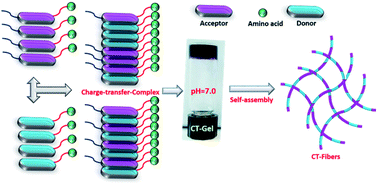
RSC Adv., 2018,8, 14753-14759
https://doi.org/10.1039/C8RA00929E
Multi-mode supermolecular polymerization driven by host–guest interactions
Multi-morphology supramolecular polymers from linear to dendritic polymerization by the introduction of azobenzene were obtained based on host–guest interaction.
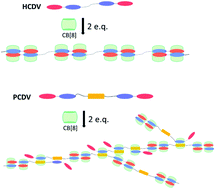
RSC Adv., 2018,8, 13722-13727
https://doi.org/10.1039/C8RA01892H
Polysulfides made from re-purposed waste are sustainable materials for removing iron from water
A polymer prepared by co-polymerisation of sulfur and canola oil removed Fe3+ from water. Microwave irradiation was convenient in promoting the polymerisation.
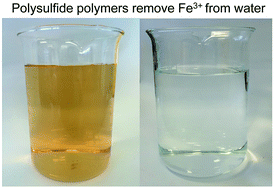
RSC Adv., 2018,8, 1232-1236
https://doi.org/10.1039/C7RA11999B
Dynamic self-assembled polymer: HCl responsive inversion of supramolecular polymer handedness
Discotic trisamide formed a self-assembled polymer and exhibits inversion of supramolecular polymer handedness in the presence of HCl.

RSC Adv., 2017,7, 47170-47176
https://doi.org/10.1039/C7RA08035B
One-pot synthesis of self-healable and recyclable ionogels based on polyamidoamine (PAMAM) dendrimers via Schiff base reaction
Novel ionogels with covalent polymeric networks based on polyamidoamine (PAMAM) dendrimers have been synthesized by the in situ crosslinking of amines via Schiff base reaction in the ionic liquid 1-ethyl-3-methylimidazolium acetate ([EMIM][OAc]).

RSC Adv., 2017,7, 38765-38772
https://doi.org/10.1039/C7RA06916B
Effect of metal–metal distance in Ni(II)-based metallo-supramolecular polymers: DNA binding and cytotoxicity
Two metallo-supramolecular polymers (polyNiL1 and polyNiL2) with different metal–metal distances were synthesized via (1 : 1) complexation of the Ni salts with bis(1,10-phenanthroline)s and their DNA binding properties and cytotoxicity were revealed.
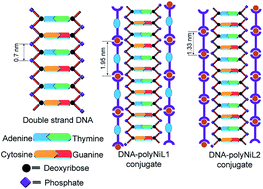
RSC Adv., 2017,7, 38008-38013
https://doi.org/10.1039/C7RA05644C
Neutral linear supramolecular polymers constructed by three different interactions
Neutral linear supramolecular polymers were constructed by the combination of quadruple hydrogen bonding, pillar[5]arene-based molecular recognition and π–π donor–acceptor interactions.
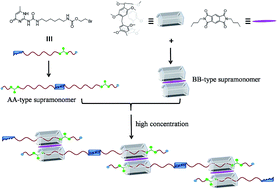
RSC Adv., 2017,7, 29364-29367
https://doi.org/10.1039/C7RA05351G
Unexpected aggregation induced circular dichroism, circular polarized luminescence and helical assembly from achiral hexaphenylsilole (HPS)
This work provides the finding of aggregation-induced circular dichroism (AICD), optical properties and helical assemblies of π–π conjugated molecule hexaphenylsilole (HPS).
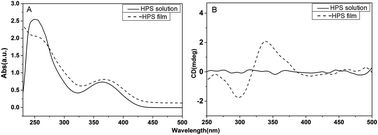
RSC Adv., 2017,7, 24841-24847
https://doi.org/10.1039/C7RA02495A
Dynamic covalent chemistry of imine polymers at the liquid/solid interface investigated by scanning tunneling microscopy
How a dynamic covalent library adapts to the presence of a surface is of fundamental importance for the design of adaptive materials. Our investigation demonstrates that the surface markedly rearrange the composition of the DCC libraries.

RSC Adv., 2017,7, 11496-11502
https://doi.org/10.1039/C6RA27395E
Synthesis and characterization of metallo-supramolecular polymers from thiophene-based unimers bearing pybox ligands
A series of novel metallo-supramolecular polymers was prepared, based on 2,6-bis(2-oxazolinyl)pyridine chelating groups bridged with thiophene, bithiophene and thienothiophene as a linker, beginning from commercially available (chelidamic) acid.
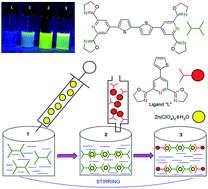
RSC Adv., 2017,7, 10718-10728
https://doi.org/10.1039/C6RA26665G
About this collection
This collection, guest-edited by RSC Advances Associate Editor Dr Sébastien Ulrich (CNRS, Université de Montpellier), features articles published in the journal on the topic of Supramolecular Polymers. Supramolecular polymers results from the poly-association of molecules through non-covalent interactions. Uniquely and because they are self-assembled through reversible linkages, these materials are dynamic and can therefore adapt to different conditions and respond to different stimuli. Although supramolecular polymers were first seen as a lab curiosity, they have now demonstrated their utility in a wide range of applications from material to biological sciences. Recent breakthroughs such as the discovery of living supramolecular polymerization make the field very active and opens up exciting new opportunities.
The collection of selected articles witnesses this blooming activity, by reporting on i) the design of new molecular building blocks that impart new structures and functions, ii) the expansion to new types of self-assembly processes, which affect the dynamic feature of the corresponding adaptive materials, iii) our understanding, modelling and characterization of the mechanism of self-assembly, and iv) on the application of these smart systems in a wide range of area from biomedicine to material science.